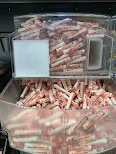Reading Portion:
In this week's reading, Doolittle's exploration of the
failures of the grid and its implications on spatial and temporal organization,
three stops along this intellectual journey stand out and spark curiosity.
First Stop: Seductive Simplicity of the Grid
The journey begins with the seductively simple nature of the
grid. This system effortlessly extends into domains like neighborhoods and
towns and three-dimensional spaces like buildings and malls. Doolittle's
analogy of gardening leading to geometry and the connection between linen and
line resonates deeply. With its straight lines and right angles, the grid provides
a sense of control, predictability, and mastery. However, the simplicity that
makes the grid appealing also raises critical questions about its adaptability
to the complexities of real-world applications. The tension in the fiber, which
creates linearity, becomes a metaphor for the tension between imposed order and
the organic growth and diversity of specific places.
Second Stop: Failures and Control
As the grid exploration progresses, Doolittle astutely
observes that failures in the grid system have been apparent since its
inception. However, responding to these failures raises essential questions
about control and ownership. The grid, deeply ingrained in our thinking, leads
to rules governing behavior, shaping our sense of control. The failure to let
go of the grid results in the subordination of a place's unique qualities to
the grid geometry's imposed uniformity. The grid is not merely a
geometric construct but a manifestation of cultural and human tendencies toward
order and control.
Third Stop: Giving Thanks and Liberation from the Grid
A fascinating turn in the journey comes with the Indigenous
perspective, introducing the idea of giving thanks and offering an alternative
solution to the Königsberg Bridges problem. Acknowledging what has been missing
from the discussion, recognizing the river as a foundation, and giving thanks
through offerings present a profound departure from the rigid confines of the
grid. The narrative weaves through philosophy, bringing in Immanuel Kant and
his habitual walks, drawing parallels to the mental abstraction imposed by
accepting Euler's negative result. The call to widen our perspective, move off the
grid, and see the world as it truly is bringing a refreshing perspective to
mathematical problem-solving.
Engaging Questions for Reflection:
- How
do the failures of the grid, as highlighted by Doolittle, resonate with
your understanding of spatial and temporal organization in various
contexts?
- How
can alternative geometries, described as "geometries of
liberation," find a place in modern mathematics education, and what
challenges might arise in incorporating them into the classroom?
Reference:
Doolittle, E. (2018). Off
the grid. In Gerofsky, S. (Ed.), Geometries
of liberation. Palgrave. https://doi.org/10.1007/978-3-319-72523-9_7
Activity Portion:
My son's drawing My spouse's drawing.
The activity described in Doolittle's "Off the
Grid" gave me a unique perspective on observing and sketching the world
around me, even if I could not go outdoors. I was sitting indoors with my
spouse and two-and-a-half-year-old son. We looked through the window; we
focused on living beings and human-made things, using watercolors and brushes
to document my observations. I did the observation, and my spouse and son made
the drawings. As I found a spot to sit and observe, I noticed various lines and
angles in the natural and human-made things. I observed natural flowing lines
like plants, trees, rocks, and the sky. The natural world seemed to express
itself through gentle curves and irregular shapes. On the other hand,
human-made things, like buildings, roads, fences, and street lights, displayed
more structured and geometric lines and angles. Therefore, the contrast between
the organic and the structured was apparent.
Reflecting on these observations, it became evident that specific
patterns emerged in both living and human-made elements. While living things
displayed a sense of irregularity, human-made objects adhered to a more ordered
and intentional design. However, there were exceptions, as nature sometimes
exhibited symmetrical patterns, and human-made structures occasionally embraced
organic forms. The patterns I observed raised questions about why such
distinctions exist. I pondered whether these patterns are inherent like things
or influenced by human perception and design choices. The contrast in
lines and angles reflects a fundamental difference in the creation processes,
one guided by nature and the other by human intention.
Considering how this activity could be translated into
teaching, close observation, and sketching could be powerful tools
for helping students understand lines and angles. By encouraging students to
explore the world around them through drawing, educators can foster a deeper
connection between their eyes and hands, promoting a more intimate
understanding of geometry in their surroundings.
Moreover, I contemplated integrating whole-body movement
into the learning experience. For instance, the video of two UBC undergraduate
students, Sam Milner and Carolina Azul Duque, demonstrates the Dancing
Euclidean Proofs. Indeed, it suggests one-way students could experience
lines and angles through activities that involve exploring the outdoors. I
wonder what other ways we can engage students with the living world to offer a
holistic understanding of geometry, connecting abstract concepts to tangible,
real-world experiences. This approach could make learning more immersive and
memorable for students.




























